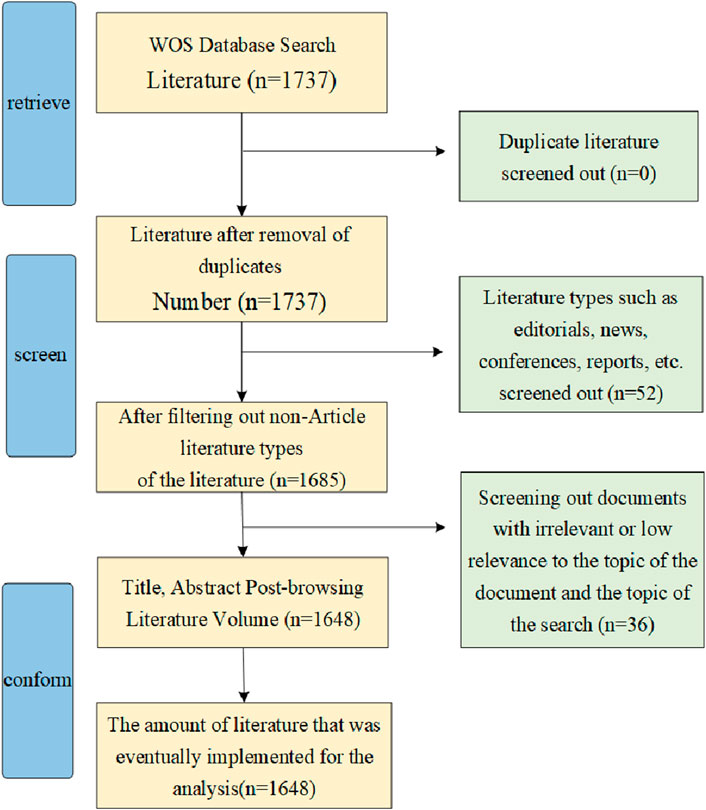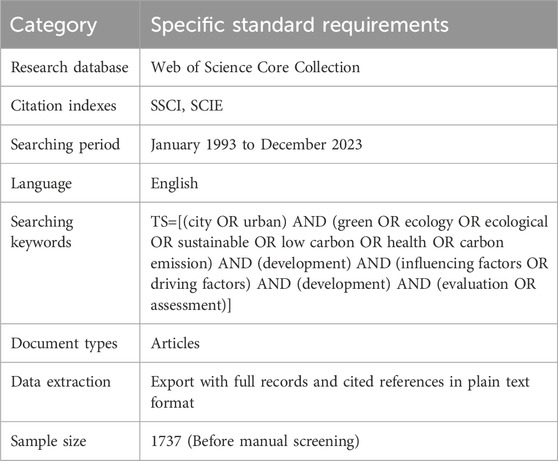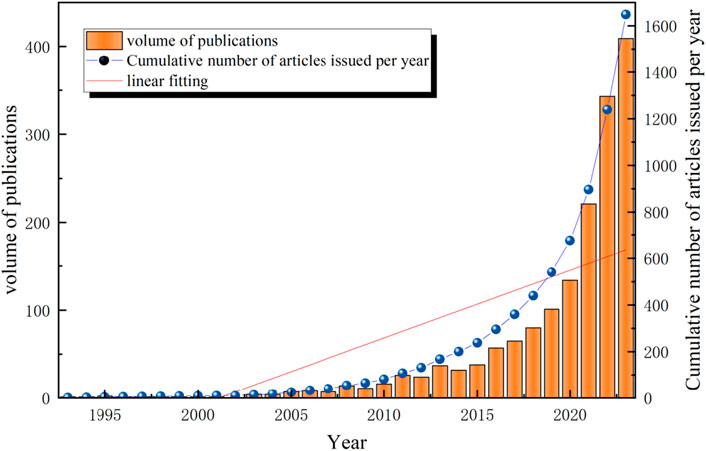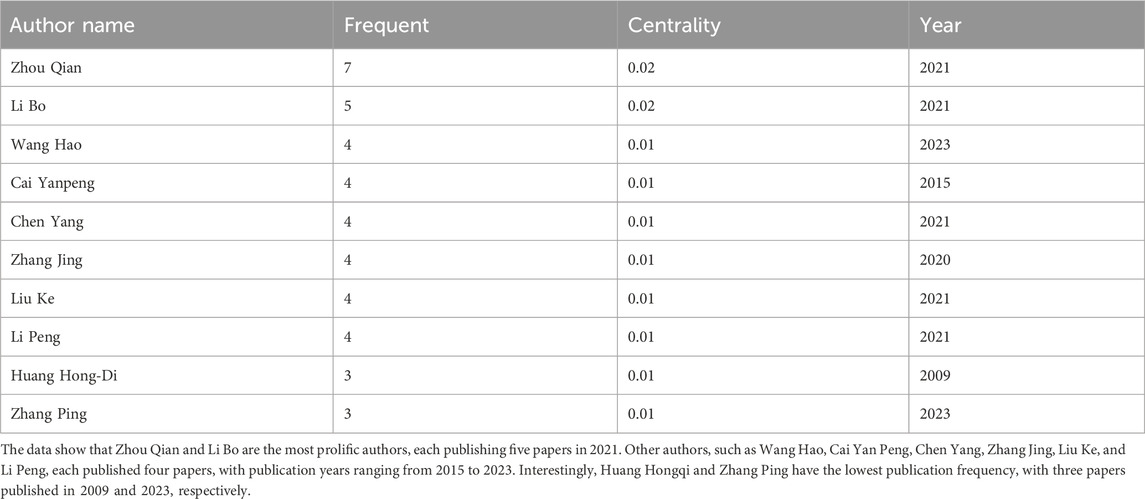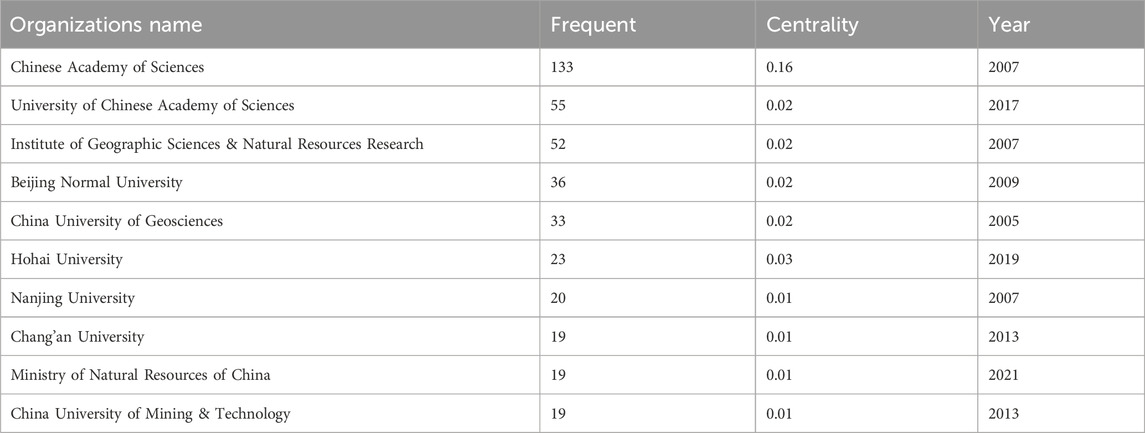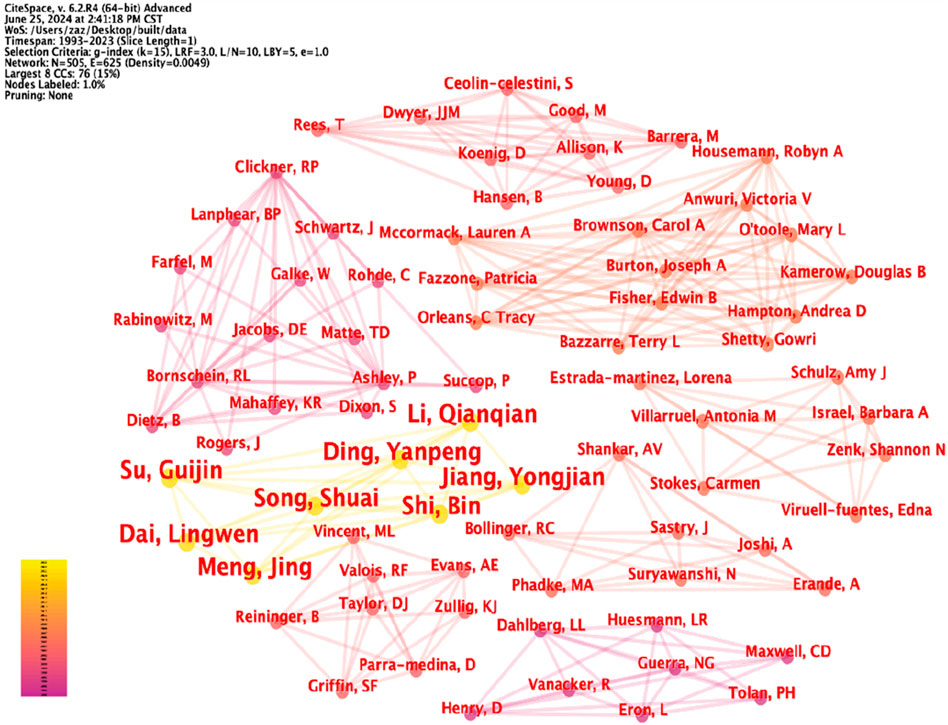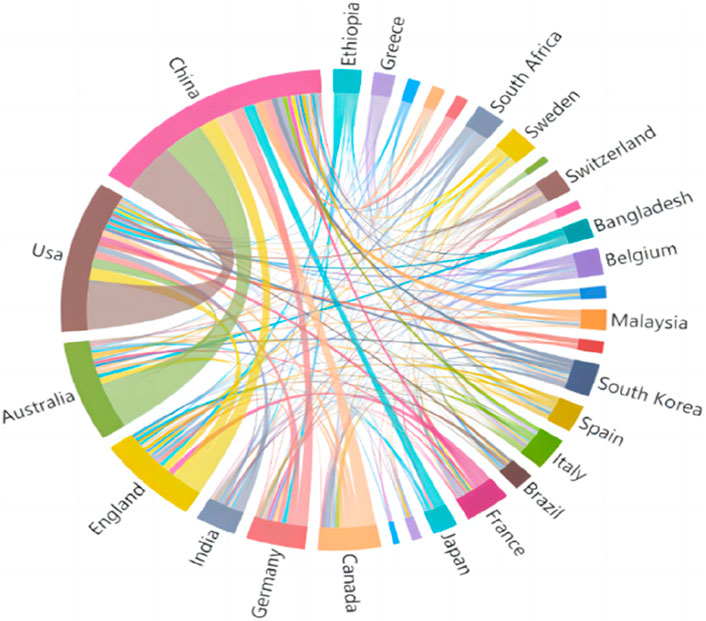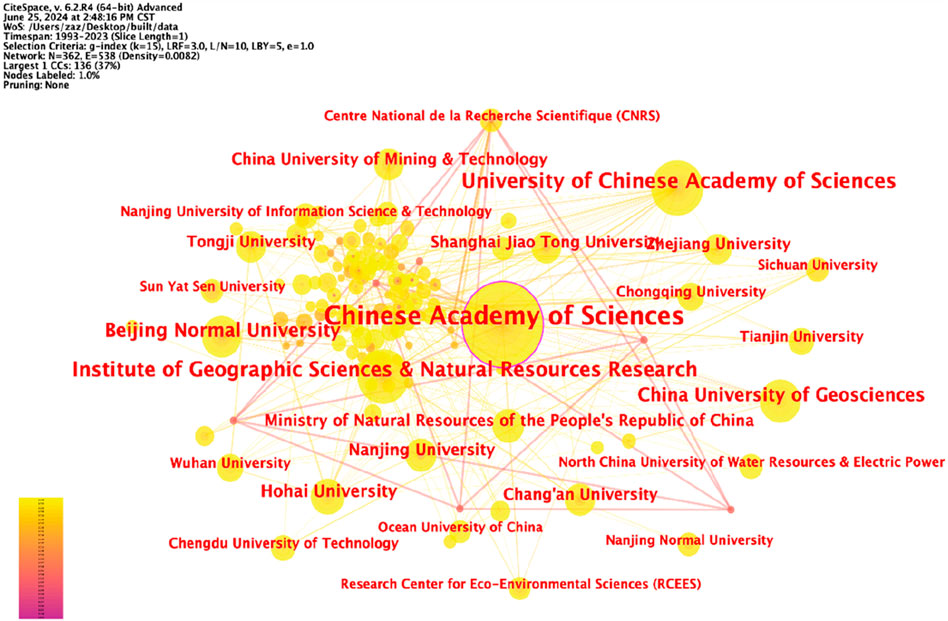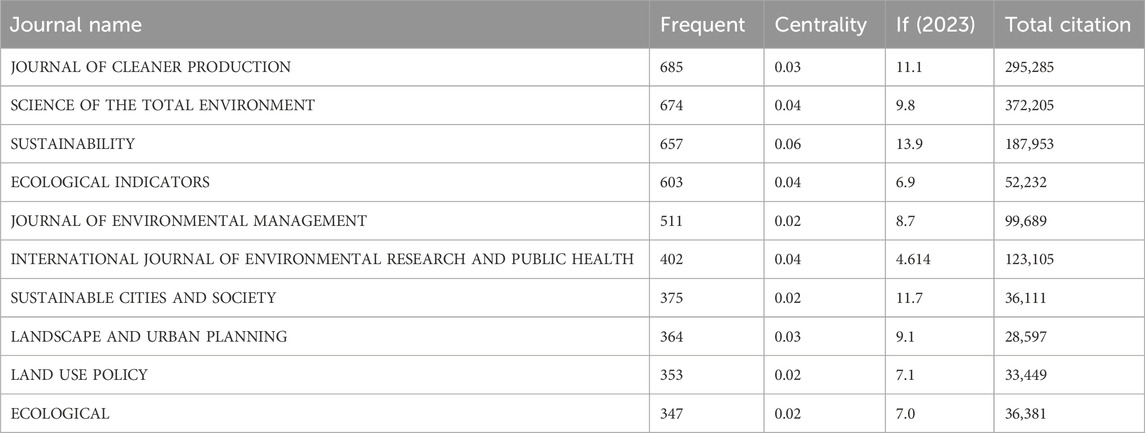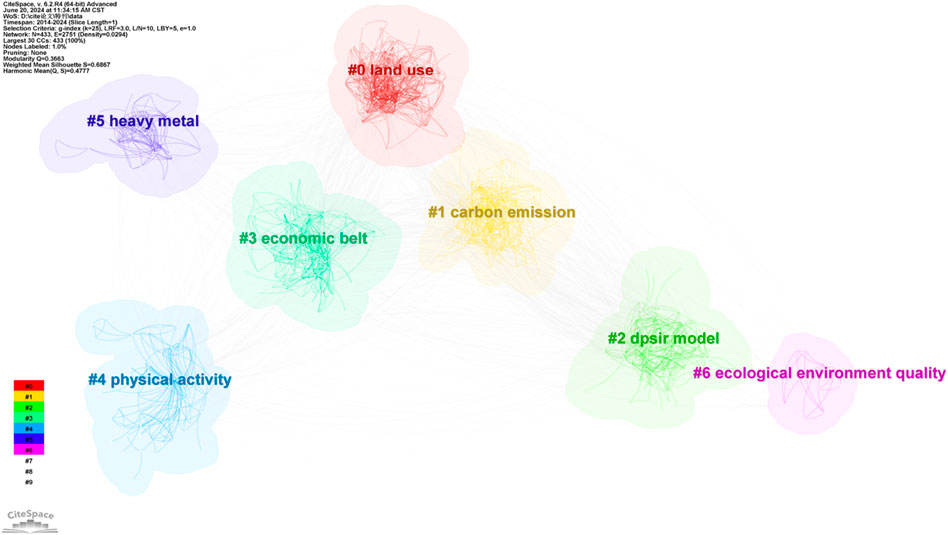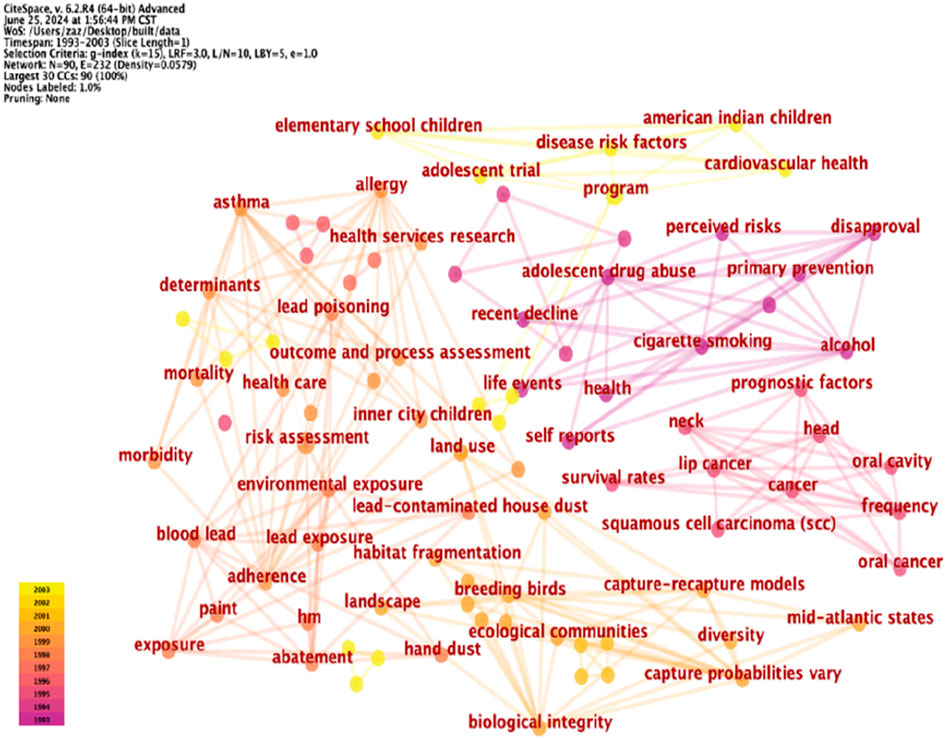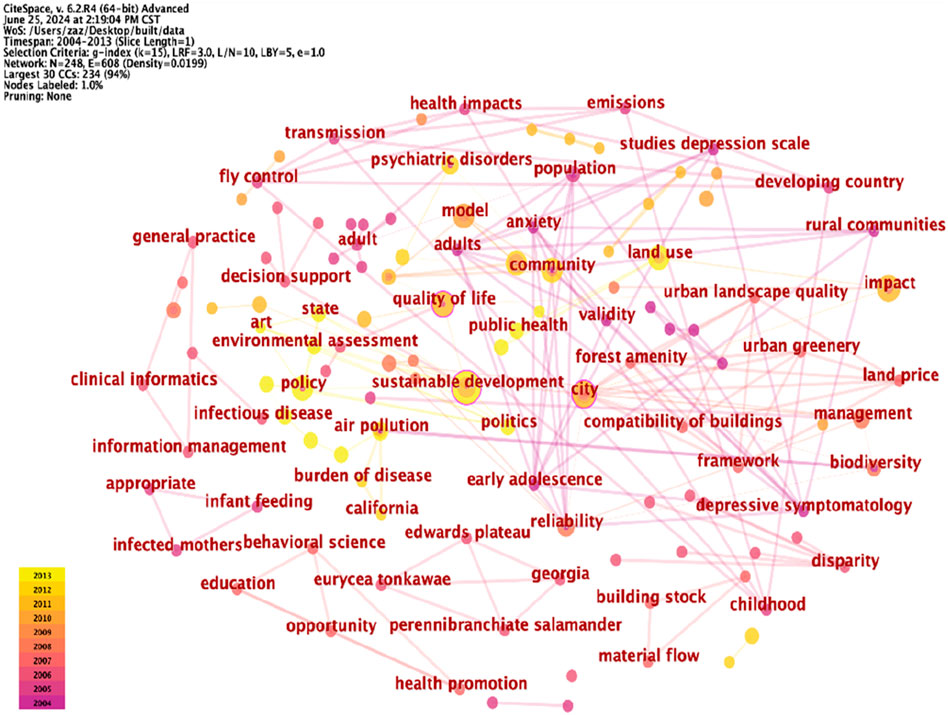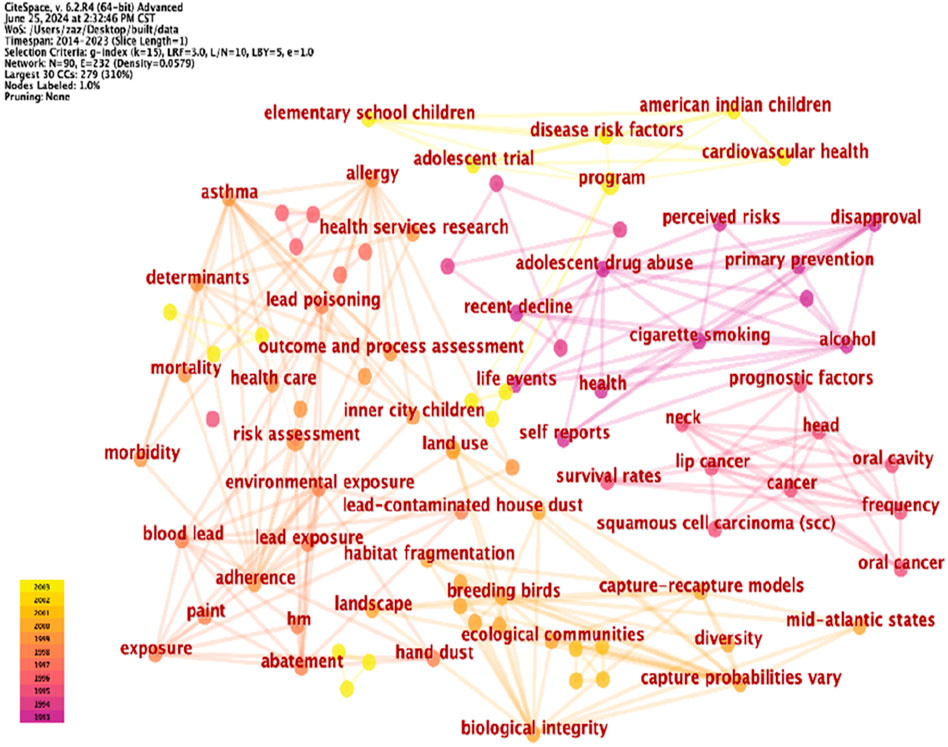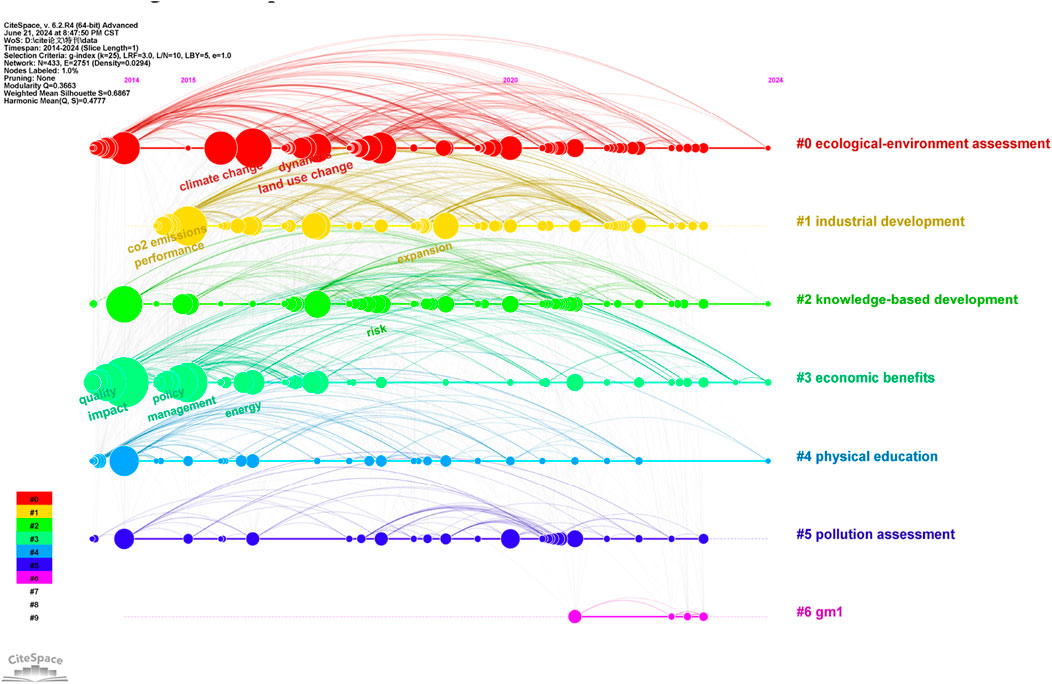- Faculty of Humanities and Social Sciences, Macao Polytechnic University, Macao, China
The escalating challenges of global climate change have made the development of low-carbon cities—urban areas committed to reducing carbon emissions through sustainable energy use, enhanced building efficiency, and low-carbon transport solutions—a critical area of study. However, there remains a significant gap in the systematic review of the thematic evolution and emerging frontiers within this field. This study addresses this gap by analyzing data from the Web of Science database, initially retrieving 1,743 articles and review articles. Following the PRISMA systematic review guidelines, we refined this selection to 1,648 high-quality publications. Using tools such as CiteSpace and VOSviewer, we conducted an in-depth analysis to identify core authors, prolific countries/regions, leading institutions, and key journals. Our thematic analysis revealed three evolutionary stages in the research on international low-carbon city development. Additionally, we identified seven predominant topics in recent studies: land use, carbon emissions, ecological environment quality, ecosystem services, human health, energy consumption, and economic costs. These findings contribute to a clearer and more comprehensive framework for the development of low-carbon cities, serving as a valuable reference for scholars and practitioners involved in both theoretical and practical aspects of this field.
1 Introduction
People increasingly view the development of low-carbon cities as a crucial strategy to address the global challenge of climate change. As urban areas are significant contributors to greenhouse gas emissions, transitioning to a low-carbon development path is essential for mitigating the adverse impacts of climate change and ensuring sustainable urban development (Zhao et al., 2024; Zhou et al., 2024). Urban development is at the forefront of both the climate change problem and its solutions (Zhu and Hu, 2023). Due to high energy consumption (Ze, 2019; Liu et al., 2023a), developed transportation networks (Wang et al., 2022; Wang et al., 2024; Wu et al., 2024), and dense populations (Habrich et al., 2021), urban areas account for a substantial portion of global carbon emissions (Chen et al., 2019; Fang et al., 2022). Therefore, developing and implementing low-carbon technologies (Nuhu et al., 2021) and policies in urban environments is vital for reducing overall emissions and achieving global climate goals (Yu et al., 2024). The concept of low-carbon city development encompasses various strategies, including energy-efficient building design (Ridha, 2022; Luo et al., 2024), integration of renewable energy (Huang et al., 2022; Yue et al., 2023), sustainable transportation systems (Yuan et al., 2018), and green infrastructure (Cai et al., 2024), all aimed at reducing the carbon footprint while enhancing the city’s adaptability and livability (Nguyen et al., 2023). Over the past three decades, against the urgent backdrop of global climate change and carbon emission reduction, research on low-carbon urban development has yielded abundant results, spanning a wide range of disciplinary fields and having a profound impact on future environmental policies (Halbac-Cotoara-Zamfir et al., 2022; Han et al., 2023; Huang et al., 2023; Peng et al., 2024; Zeng et al., 2024) and technological innovation (Yu et al., 2023; Li et al., 2024a; Zhang et al., 2024).
Recent bibliometric studies have prominently shown an increasing interest in the academic community regarding the development of low-carbon cities, reflecting its interdisciplinary nature across environmental sciences, urban planning, policy research, and engineering (Lu et al., 2022; Crippa et al., 2023; Liu et al., 2023b; Wang et al., 2023a; Wang et al., 2023b). However, existing literature often lacks a systematic review of the evolution of topics and emerging frontiers in this field. To address this research gap. This study utilized advanced bibliometric tools, specifically CiteSpace and VOSviewer. CiteSpace was employed to detect and visualize key nodes and citation bursts within the literature, helping to identify core authors and influential institutions shaping low-carbon city research. Concurrently, VOSviewer was used to construct and analyze networks of journals, countries, and regions based on citation and co-authorship data, facilitating the identification of high-yield countries/regions and prominent journals in the field. These tools collectively enabled a comprehensive analysis of research trends and major contributors, highlighting the evolving themes within low-carbon city development literature (Gu et al., 2022; Liu et al., 2022; Bi et al., 2023; Wang et al., 2023a; Lin et al., 2024; Yan et al., 2024).
This study provides a comprehensive bibliometric analysis of hot topics and cutting-edge evolutions in low-carbon city development from a global perspective. This study carefully examined all relevant literature from 1993 to 2023 in the Web of Science (WOS) database to better understand how research on measuring and evaluating low-carbon development levels in cities has evolved over time. Some significant findings were obtained by meticulously counting the number of publications each year and observing the annual trends, as revealed in Figure 1. To handle temporal changes in research focus, the study divided the analysis into three distinct periods: the embryonic stage (1993–2003), the development stage (2004–2013), and the expansion stage (2014–2023). Each stage was characterized by different research priorities and methodological approaches, reflecting the shifting focus and maturation of the field over time. The study identifies the main research hotspots and outlines the knowledge structure of low-carbon city development by examining global research outcomes. The analysis reveals key areas such as sustainable urban planning, urban energy transition, climate-adaptive infrastructure, and policy frameworks that support low-carbon initiatives. Additionally, the research depicts the cooperative networks among countries, institutions, and researchers, highlighting the interdisciplinary and international nature of the field’s research.
This study aims to provide valuable insights into the current status and future directions of low-carbon city development research through bibliometric analysis. It highlights the importance of continuous innovation and collaboration in advancing global sustainable urban development practices. This comprehensive review can be a foundational resource for researchers, policymakers, and practitioners committed to promoting low-carbon, sustainable urban environments.
In summary, this study aims to address the following questions:
(1) Since the early 1990s of this century, how has low-carbon city research been distributed among authors, countries/regions, institutions, and journals?
(2) What are the trends in low-carbon city research over the past 30 years?
(3) What are cutting-edge fields in low-carbon city development research?
2 Literature review
Research on the development of low-carbon cities began in the early 20th century, with early studies focusing on the environmental impact assessment and resource management of low-carbon city development (Sang et al., 2024). The development of low-carbon cities includes the impacts on the environment, economy, social structure, and health (Wang et al., 2023a; Zhu and Hu, 2023; Li et al., 2024b). Various studies have explored various issues related to the development of low-carbon cities from multiple perspectives, including changes in ecosystems, health risks, economic development models, resource management, and the Sustainability of urban planning (Cai et al., 2017; Fang et al., 2022; Lu et al., 2022). These studies have employed a variety of methods and tools, such as geographic information systems, multi-criteria decision analysis, system indicator assessment, and ecological footprint models, aiming to provide an in-depth understanding of the diverse issues in the development of low-carbon cities (Song and Li, 2012; Lin et al., 2016). Research on the development of low-carbon cities began in the early 20th century, with early studies focusing on the environmental impact assessment and resource management of low-carbon city development (Pandey et al., 2023). The development of low-carbon cities includes impacts on the environment, economy, social structure, and health (Zywiolek et al., 2021; Huang and Huang, 2023; Huang et al., 2024). Various studies have explored various issues related to the development of low-carbon cities from multiple perspectives, including changes in ecosystems, health risks, economic development models, resource management, and the Sustainability of urban planning (Giri et al., 2019; Jamal and Ahmad, 2020; Shen et al., 2024). These studies have employed a variety of methods and tools, such as geographic information systems, multi-criteria decision analysis, system indicator assessment, and ecological footprint models, aiming to provide an in-depth understanding of the diverse issues in the development of low-carbon cities (Waterhouse et al., 2013; Ge et al., 2015; Hu et al., 2021; Shen et al., 2024).
In terms of low-carbon city planning and management, research on the quantification of the degree of sustainable development of resources (Dong et al., 2021; Wang and Wang, 2023). Dai et al. (2021) proposed an evaluation model for the sustainable development of mineral resources, demonstrating the application of systems science in managing resources in low-carbon cities. Framework research on urban environmental health risks: Ezzati et al. (2005) discussed the development of environmental health risk exposure indicators, which are significant for urban public health policies.
In addition, research in low-carbon technologies and applications includes. Implementing low-carbon technologies in cities (Zhao et al., 2023). Zhao et al. (2024) Water Resources Evaluation for Low-Carbon Cities Based on the DPSIR Framework. Asaad et al. (2023) study the application of low-carbon technologies and policy effects in cities along the Yellow Sea using the DEMATEL model and dynamic cluster analysis. Evaluation of low carbon development efficiency: Lin et al. (2023), Lin et al. (2023) apply the entropy weight-TOPSIS method to analyze and evaluate the efficiency of low carbon development in cities and provide decision-making support for city managers. Application of Satellite Remote Sensing Technology in Environmental Monitoring (Bai et al., 2023; Chen and Yao, 2023; Peng et al., 2023). Shepherd et al. (2004), Shepherd et al. (2004) used satellite remote sensing data to study the urban heat island effect, providing a scientific basis for understanding the impact of urbanization on regional climate. Assessment of urban soil resources: Hossack et al. (2004), Hossack et al. (2004) developed decision support tools to assess urban soil resources and analyze their role in urban ecosystems, reflecting the importance of urban soil management. Resource-environmental modelling in a system perspective (Ercan et al., 2017; Glaas et al., 2018; Ma et al., 2022; Yu et al., 2024). Ma et al. (2022) constructed the Super-NEBM model based on a two-stage resource-environmental system perspective, integrating resource efficiency and environmental impacts. Application of Models in Urban Policy Evaluation: Hou et al. (2023) and He et al. (2022) analyzed the impact of low-carbon policies on urban development using the DPSIR framework and the ISPA-VFSM model, highlighting the importance of models in policy evaluation. Advances in urban remote sensing monitoring: Jiao et al. (2022) analyzed the changes in low-carbon urban environments by using the Remote Sensing Eco-Index (RSEI) model through an integrated assessment, showing the advancement of remote sensing technology in monitoring urban ecological health. Predicting and Identifying Low-Carbon Urban Development Trends (Chen et al., 2022; Lu et al., 2022; Lei et al., 2023; Lu et al., 2023). Mou et al. (2023) predicted and identified urban land-use changes using the PLUS model and the K-Medoids algorithm, providing insights into future urban planning (Zhu et al., 2022).
Secondly, in the research on policies and strategies for low-carbon city development. Comprehensive evaluation of low-carbon policies. Studied the actual effects of low-carbon policies on urban sustainable development by combining the DPSIR framework and the ISPA-VFSM model, providing significant references for policy formulation (Wang and Fu, 2023; Lu and Feng, 2024; Zhao et al., 2024). Research on strategies for urban low-carbon development: investigated the implementation effects of urban low-carbon development strategies, assessing the influence and correlation of various strategies through the DEMATEL model (Trembecka et al., 2023; Xu et al., 2023; Chen et al., 2024).
With time, the focus of low-carbon city research gradually shifted to applying low-carbon technologies and urban planning strategies. The 20th decade of the 21st century saw a widespread application of technological innovations and systematic approaches to urban low-carbon development strategies. Fang et al. (2022) used the DEMATEL model and dynamic clustering algorithms to study the low-carbon development strategies of cities along the Yellow Sea coast, highlighting the role of advanced analytical tools in forming effective low-carbon policies. Meanwhile, Lin et al. (2022) evaluated the low-carbon development efficiency of Chinese cities through the entropy weight-TOPSIS method, and these studies helped policymakers and urban planners formulate more scientific and precise low-carbon development plans. By comprehensively considering the interactions among technological advancements, systems approaches, and policy-making, low-carbon city research provides multidimensional solutions for urban sustainable development. These studies have improved urban planning and management by introducing advanced technologies and methods, enhanced the adaptability of cities to environmental changes, and promoted harmonious development between socio-economics and environmental protection.
The above literature review reveals a multidisciplinary and highly integrated research trend in low-carbon city development research, with a tightening connection between research outcomes and urban policy-making. Future research can further explore the innovation and practical application of low-carbon technologies, as well as how to more effectively translate scientific research achievements into urban policies and practices to promote sustainable development on a global scale. Developing low-carbon cities is a complex and multidimensional process involving environmental monitoring technology and policy-making. Future research can further explore the intersections within these fields, especially how to leverage technological innovation to support more sustainable urbanization strategies. These research findings provide valuable insights and tools for policymakers and urban planners to promote the low-carbon transformation of cities worldwide.
3 Methodology and materials
3.1 Research method: bibliometric
Bibliometrics is a quantitative analytical method that, through the statistical analysis of the quantity, quality, and citation situation of academic literature, reveals the dynamics, trends, and academic influence of scholarly research. From its inception at the start of the 20th century, bibliometrics emerged as an independent discipline in 1969 and has since found widespread application in literature analysis (Bar-Ilan et al., 2016). Bibliometric analysis provides a quantitative method for reviewing and investigating existing literature in a specific field (Diem and Wolter, 2013). Detailed information about authors, keywords, journals, countries, institutions, and references can be obtained during the analysis process. Thus, the development of a field can be obtained through bibliometric analysis (Abramo and D’Angelo, 2011). However, the use of bibliometric tools like Cite Space and VOSviewer comes with certain limitations. These tools rely heavily on the quality and completeness of the data in the databases, which can lead to biases if certain publications are underrepresented or excluded. Additionally, the algorithms used for clustering and visualizing data may introduce subjective elements that affect the interpretation of results. These limitations might impact the study’s findings by potentially overlooking emerging trends not well-represented in the data or misinterpreting the significance of certain research contributions. Acknowledging these limitations is crucial for providing a balanced perspective on the study’s outcomes.
Furthermore, besides the papers, most items within the papers, including authors, keywords, institutions, and countries, can be applied through this method. Visualization aids in mining the intrinsic relationships between this information, such as different authors having the same research topics, different institutional research focuses, new theories from existing institutions, etc. Bibliometric analysis typically uses CiteSpace and VOSviewer to construct knowledge maps. Both software have their own merits and can complement each other’s advantages. CiteSpace employs a set theory-based data standardization method for measuring the similarity of knowledge units, with similarity algorithms used to obtain timezone and timeline views within time slices, thus allowing for a clear delineation of the process of knowledge evolution and the historical span of literature within certain clusters over time to understand the development process and trends in the field. VOSviewer adopts a probability theory-based data standardization method, offering various visualization views in areas such as keywords, co-institution, and co-authors, including network visualization, overlay visualization, and density visualization, characterized by easy mapping and aesthetically pleasing images.
This study primarily utilizes CiteSpace and VOSviewer, two visualization software, to meticulously comb and analyze key literature, hot topics, and development trends of measurement methods and driving factors in low-carbon city research. The study uses this method to show the global research hotspots, the logic of how topics change over time, and the most recent progress in measurement methods and driving factors in low-carbon city research. This will help future studies that are similar by giving references and direction.
3.2 Data retrieval
This article selects the Web of Science (core collection) as the data source. To ensure comprehensive and accurate retrieval of data, the indexes chosen are SCI and SSCI. The final search strategy determined in this article is TS=[(city OR urban) AND (green OR ecology OR ecological OR sustainable OR low carbon OR health OR carbon emission) AND (development) AND (influencing factors OR driving factors) AND (evaluation OR assessment)] as the search expression, with the time set from January 1993 to December 2023, and the document types selected are Articles and Review Articles. The initial search yielded 1737 documents (in Table 1).
3.3 Literature screening
The literature obtained through retrieval often contains some irrelevant items that seem related; hence, to ensure that the literature included in the analysis is closely related to the topic of this study, it is often necessary to manually select the final literature for analysis after the initial literature search. Following the PRISMA systematic review guidelines, we rigorously selected 1,648 high-quality publications based on specific criteria: relevance to low-carbon urban development, high citation counts, recent publication dates to ensure current relevance, and inclusion in high-impact factor journals. This selection process aimed to ensure that our analysis encompassed the most influential and pertinent contributions to the field (Figure 2). We finally selected a total of 1,648 articles that met the research criteria.
4 Performance analysis
This section primarily provides a descriptive statistical analysis of the overall development trend of international low-carbon city research, including authors, countries, institutions, and journals. It uses a visual map to display the cooperative relationships between countries and the field’s evolutionary development status.
4.1 Time trend of the publications
This study carefully looked at all the relevant literature from 1993 to 2023 in the Web of Science (WOS) database to better understand how research on measuring and evaluating low-carbon development levels in cities has changed over time and where it is now. Some significant findings were obtained by meticulously counting the number of publications each year and observing the annual trends, as revealed in Figure 2. Through the statistical analysis of the relevant literature in the WOS database from 1993 to 2023, it can be seen that the research on the measurement and evaluation of urban low-carbon development levels has experienced a process from stable development to rapid growth and has reached an unprecedented level of activity in recent years. This trend reflects the global emphasis on urban low-carbon development and provides abundant material and a wide space for future related research.
Specifically, before 2004, the number of research publications in this field continued to grow, but the growth rate was relatively stable and slow. However, starting in 2005, the number of related research publications began to increase significantly, with the output of literature soaring and showing an exponential growth pattern. Data shows that in 2005, there were only 7 publications, while by 2020, this number had soared to 134. More notably, by 2023, the number of related research publications had reached a peak of 409.
This notable growth trend not only reflects the increasing attention from both the academic and practical sectors in measuring and evaluating the level of low-carbon development in cities but also suggests the widespread emphasis on sustainable development, environmental protection, and global climate change challenges. With the rapid advancement of urbanization and increasingly severe environmental issues, how to scientifically and effectively assess and enhance low-carbon development in cities has become an urgent issue to be addressed. Therefore, more and more researchers are devoting themselves to this field, attempting to provide theoretical support and practical guidance for the low-carbon transformation of cities through in-depth research.
This notable growth trend not only reflects the increasing attention from both the academic and practical sectors in measuring and evaluating the level of low-carbon development in cities but also suggests the widespread emphasis on sustainable development, environmental protection, and global climate change challenges. With the rapid advancement of urbanization and the increasingly severe environmental issues, how to scientifically and effectively assess and enhance low-carbon development in cities has become an urgent issue to be addressed. Therefore, more and more researchers are devoting themselves to this field, attempting to provide theoretical support and practical guidance for the low-carbon transformation of cities through in-depth research.
4.2 Quantitative analysis of the author
Analyzing the publication volume of authors can reveal representative scholars and core research forces in the field of international low-carbon development research. Table 2 presents the relevant information about core authors in this field, including their names, number of publications, and the starting date of publication. Price’s Law reveals that in any scientific field, a group of highly productive authors write about half of the papers, approximately equal to the square root of the total number of authors. According to Price’s Law, core authors who measure and evaluate urban low-carbon development must have a minimum number of publications. Therefore, in the field of carbon emission reduction, scholars with a publication count of no less than can be considered core authors in this field. According to this criterion, 158 scholars meet the standard of core authors. Analyzing the collaboration among the core authors, it is found that they are roughly affiliated with Zhou Qian’s research team, focusing on energy system analysis, dedicated to exploring and optimizing energy use and distribution methods to achieve more efficient and sustainable energy utilization.
Furthermore, they are actively researching energy models, creating accurate models to mimic and forecast the dynamic fluctuations of energy systems, thereby offering a scientific foundation for developing energy policies. Regarding climate policy assessment, she evaluates the impact of different policies on the environment and economy, providing strategic recommendations for addressing climate change. Meanwhile, Zhou Qian is also skilled in input-output analysis, quantifying the flow of resources and the value creation process in economic activities, revealing the intrinsic laws and potential opportunities for industrial development. These studies not only contribute to the advancement of the discipline but also provide strong support for the country’s sustainable development and environmental protection.
4.3 Quantitative analysis of countries/regions and organizations
To understand which countries have made the most significant contributions to international low-carbon city research, this study analyzed 1,684 articles associated with 75 countries. Table 3 presents the top five countries in terms of publication volume in this field.
To clearly understand the number of publications from different countries and their cooperative relationships, this study draws a chord diagram to present the top 30 countries by publication volume, as shown in Figure 3. The chord diagram is composed of nodes and chords: nodes are scattered along the circumference, with the length of the nodes representing the number of publications (the longer the node, the higher the number of publications); the weighted (wide) arcs connecting any two points on the circle are called chords, representing the cooperative relationship between them, with the width of the arc indicating the degree of cooperation (the wider the arc, the closer the cooperation). In terms of cooperative relationships, countries with major publications in the field of low-carbon city research all have cooperation to some extent, which can be considered relatively close international academic exchanges in the field of low-carbon city research, with a high degree of internationalization in academic research. Figure 3 reveals a trend of multiploidization in the distribution of research areas on factors affecting low-carbon development in cities, with China, Europe, and Australia being the main centres. Although China has many related studies, the degree of centrality is relatively low (0.09), clearly showing the insufficiency of authority and influence and relatively less cooperation and interaction with other countries in this field in Figure 4. The cooperation network of countries and regions consists of 117 nodes and 730 connections, with a network density of only 0.1076. This indicates that the research areas on factors affecting the level of low-carbon development in cities are scattered, and there is less cooperation between authors from different countries and regions, resulting in a relatively dispersed distribution of research areas.
Further analysis of the issuing agencies is conducted, with Table 3 presenting the top 10 organizations regarding the number of publications. Among them, the Chinese Academy of Sciences and the University of Chinese Academy of Sciences, which are affiliated with China, have the highest number of publications in the field of low-carbon city development, with 133 and 55 papers, respectively in Figure 5. In contrast, the Institute of Geographic Sciences & Natural Resources Research has the highest average citation rate of 52 per paper among the top 10 organizations. In addition, among the top 10 organizations in terms of the number of publications, 9 are located in China, which, to some extent, reflects the leading position of Chinese scientific research institutions in this field of study.
4.4 Analysis of journals publishing articles
To accurately identify academic journals with significant influence in measuring and evaluating the level of urban low-carbon development and its influencing factors, this study conducted a detailed statistical analysis of the number of related papers published by each journal. Given the large number and uneven distribution of journals related to the research on measuring and evaluating the level of urban low-carbon development and its influencing factors, these journals not only dominate in quantity but also reflect a high academic standard in quality, representing the core research achievements in the field.
The Web of Science database’s analysis of journal types revealed that fields like sustainable development, resource and environmental management, health management, and urban management primarily house journals that study factors influencing the level of urban low-carbon development. Journals in these fields tend to focus on the interaction between the environment and human activities and how to achieve sustainable resource use and green development in cities through scientific management.
Overall, the journals listed in Table 4 provide significant support for studying factors influencing low-carbon urban development with high professionalism. This table lists the measurement, evaluation, and influencing factors in urban low-carbon development.
We have identified relevant academic journals and some of their key indicators. Among these journals, JOURNAL OF CLEANER PRODUCTION stands out for its significant contribution to the study of factors influencing the level of urban low-carbon development, with a total of 676 publications, a centrality of 0.03, an impact factor of 11.1 in 2023, and a total of 295,285 citations, ranking at the top. The journal focuses on cleaner production, sustainable consumption, and resource efficiency. It provides abundant theoretical and practical results for measuring and evaluating urban low-carbon development levels, demonstrating its strong influence and leading role in the field. SCIENCE OF THE TOTAL ENVIRONMENT follows with 674 citations, a centrality of 0.04, an impact factor of 9.8, and 372,205 citations. Sustainability ranks third with 657 citations, a centrality of 0.06, and an impact factor as high as 13.9, for a total of 187,953 citations. These figures demonstrate the significant influence and wide academic recognition of these journals in urban low-carbon development research, with Sustainability boasting the highest impact factor, indicating its notable influence in sustainable development. Other journals, such as ECOLOGICAL INDICATORS, Journals such as the Journal of Environmental Management also exhibit high centrality and impact factors, indicating their significant role in environmental management and ecosystem assessment. The research outcomes from these journals are important reference points for guiding urban low-carbon development, environmental protection, and sustainable urban planning. These journals provide a platform for researchers to exchange and present their latest research findings and offer significant references for guiding urban low-carbon development, environmental protection, and sustainable urban planning. Through research in these frequently published journals, we can gain an in-depth understanding of the current status, challenges, and future trends of urban low-carbon development, providing a scientific basis and strategic recommendations for promoting sustainable urban development.
5 Temporal keyword analysis: thematic evolution
5.1 Keyword clustering
Keyword clustering analysis provides researchers with a powerful tool to reveal hotspots and trends within a research field. This study utilized Citespace software’s clustering function to conduct a detailed keyword clustering analysis, aiming to explore the core thematic structure of the literature on the measurement and evaluation of urban low-carbon development levels and their influencing factors. We meticulously processed the clustering results, eliminating keywords with weak identification to draw a clear clustering distribution map, as illustrated in Figure 3. Figure 3 reveals a wide range of content in the research on measuring and evaluating urban low-carbon development levels and influencing factors, leading to the formation of numerous research clusters. These clusters encompass various research methods, such as factor analysis, clustering analysis, comprehensive evaluation, and coupling coordination degree, but also involve various specific topics, including land use, carbon emissions, the Desir model, the economic belt, physical activity, and ecological environment quality.
Researchers have meticulously classified and evaluated land use patterns in different regions using spatial analysis and Geographic Information System (GIS) technologies. For instance, through factor analysis, researchers can identify the main factors influencing land use change, such as economic development, population density, and policy orientation. Moreover, cluster analysis helps researchers group regions with similar land use characteristics, providing a scientific basis for local governments to develop more targeted land management strategies. Based on this, researchers have applied comprehensive evaluation and coupled coordination degree models to assess the level of carbon emissions in different industries and their relationship with economic growth. These studies reveal the complex connections between economic development and environmental protection and provide theoretical support for formulating low-carbon economic development strategies. By simulating how the system would react to different policy scenarios, researchers have used the DESIR model, which models the interactions between social, economic, and environmental systems, to help policymakers figure out how to balance social progress and environmental protection. This model, especially in research on economic belt development, has demonstrated the long-term impact and Sustainability issues of regional development policies. Research in physical activity has focused on the relationship between people’s lifestyles and health. Using comprehensive evaluation methods, researchers have assessed the level of physical activity in different populations and explored various social and environmental factors that promote physical activity. Finally, researchers have used the coupled coordination degree model to evaluate the interaction between ecosystem service functions and human activities in studying ecological environment quality. These studies emphasize the coordination between ecological protection and social and economic development, providing important scientific evidence for achieving sustainable development goals. In summary, these diverse research methods and topics have enriched academic discussions in social and natural sciences and provided practical tools and strategies for solving complex real-world problems.
Specifically, the keyword clustering map in the WOS data further illustrates the distribution of these clusters. For example, the indicator system cluster talks about how to make a scientific evaluation indicator system to measure low-carbon development in cities. The research methodology cluster, on the other hand, focuses on how to make and use evaluation methods and models. Finally, the topic clusters talk about different types of research, like how changing land use affects carbon emissions and how to balance environmental protection and economic growth.
Additionally, the clustering map presents cross-level clustering variables, which reflect that different clusters are not completely independent in the actual research process but are interconnected and intersecting. This cross-disciplinary intersection indicates that measurement and evaluation research on the level of low-carbon development in cities is a complex system that is multidimensional and interdisciplinary, involving the interaction and impact of various aspects such as economy, environment, and society.
This research not only identifies several current hot topics in the field, such as land use, carbon emissions, and energy consumption, but also suggests actionable strategies to address these challenges. We recommend the formulation of urban planning policies that promote green building practices, the enactment of stringent carbon emissions regulations, including carbon taxes, and the support of renewable energy transitions through government incentives. These strategies aim to operationalize the findings into practical applications that significantly contribute to the development of sustainable, low-carbon cities. The clustering analysis of these high-frequency keywords also provides an intuitive visual mapping for understanding the research structure and trends within the field, which helps researchers and policymakers better grasp the dynamics of the research and formulate corresponding strategies and measures.
The research on the measurement and evaluation of the level of low-carbon development in global cities and its influencing factors is a complex process involving multiple aspects, including historical data analysis, the evolution of research methods, observation of international trends, action patterns of different countries, current situation assessment, and prospects. Through a comprehensive analysis of these dimensions, a more comprehensive understanding of the dynamics and challenges of global carbon reduction can be obtained, which provides support for formulating effective emission reduction strategies.
5.2 Logic of frontier evolution
Cite Space is used in this study to do a high-frequency keyword evolution analysis on 1,648 target references. Figure 6 shows how the research tracked and observed the dynamic development process and cutting-edge topics throughout the research journey. It's clear from the placement of keywords and the strength of their connections that research on measuring and evaluating global urban low-carbon development levels and the factors that affect them follows a certain pattern, which can be roughly broken down into three stages: 1993–2003: keywords are relatively independent, marking the first stage (incubation period in Figure 7); 2004–2013: keywords become more refined and their relationships gradually become closer, marking the second stage (exploration period in Figure 8); from 2014 to 2023, new terminologies further evolve and develop, marking the third stage (development period in Figure 9).
The first stage is the embryonic stage. In this stage, researchers typically focus on establishing foundational theories and identifying core issues. For example, in the field of climate change, this may include the preliminary classification of greenhouse gas emission sources, the basic impacts of climate change on agriculture and ecosystems, etc. These early studies laid the foundation for subsequent in-depth exploration and began to construct the conceptual framework of the entire research field. Furthermore, these studies aid in comprehending the interrelationships among various regions and industries and the impact of climate change on them. These studies allow us to predict potential future problems better and take appropriate measures to address them. Therefore, these early studies are important for understanding and responding to global warming and other issues.
The second stage, the development stage, is at this point. Research focuses on applying theoretical knowledge to practical problem-solving and technological development. This trend is represented in the figure by keywords such as “ecosystem services,” “human health,” “energy consumption,” and “economic costs.” For instance, studies focus on how ecosystem services influence human health, the financial implications of energy usage, and the influence of urbanization on these aspects. This research promotes scientific progress and facilitates policy-making and practical application, such as designing and implementing green infrastructure projects and improving risk assessment methods.
The third stage is the expansion phase. On the far right of the graph, some larger circles and dense connections can be seen, indicating that certain topics or concepts have become the core of research and that multiple research fields have begun to integrate. This stage’s research outcomes are typically comprehensive in scope. For example, in the field of climate change, research may focus on the impact of global warming on economic corridors, the interaction between ecological security and biodiversity conservation, and so on. These studies often require interdisciplinary cooperation involving climate science, economics, sociology, ecology, etc. Research in this stage promotes scientific progress and facilitates policy-making and practical application, such as designing and implementing green infrastructure projects, improving risk assessment methods, and so on.
Overall, from left to right, the figure illustrates the process of a research field from its inception, development, and maturity, with each stage having its characteristics: the early stage is about exploration and foundation-laying, the middle stage is about expansion and deepening, and the later stage is about integration and interdisciplinary cooperation.
5.3 Frontier evolution keyword maps and clustering maps
Keyword co-occurrence maps and clustering maps indicate that the research perspective on measuring and evaluating urban low-carbon development levels is gradually diversifying, and the research content is also continuously enriching. By further organizing and integrating these clusters and representative literature, it can be known that the research on urban low-carbon development can be deeply analyzed in the following three aspects in Figure 10.
(1) As for the ecological evaluation index system, in evaluating the low-carbon, sustainable development of cities, the ecological evaluation index system plays an indispensable role. A unified standard for the evaluation index system of urban low-carbon development remains unformed, as the low-carbon sustainable development of cities involves multiple levels and continuously acquires new connotations with the evolution of time.
From the perspective of transformational development. The study focused on the three major aspects of economic, social, and environmental transformation, constructing a low-carbon transformation evaluation index system for coal resource-exhausted cities. These studies not only provide rich theoretical insights but also offer practical evaluation tools for the low-carbon development of cities. We can better understand the multidimensional characteristics of urban low-carbon sustainable development by comparing and analyzing evaluation indicator systems from various perspectives, which in turn supports the formulation of more effective policies. Collectively, the research outcomes represent a valuable asset in pursuing urban low-carbonization, guiding the future direction of sustainable urban development.
(2) Aspects of the categories of influencing factors. In exploring the complexity of low-carbon sustainable development in cities, scholars have systematically analyzed it from a wide and deep perspective. In summary, the factors influencing cities’ low-carbon, sustainable development are diverse and complex, involving aspects such as the natural environment, socio-economics, industrial development, and energy structure. Starting from different perspectives, scholars have provided comprehensive and profound insights through in-depth research and theoretical exploration. These research findings help to understand the intrinsic mechanisms of urban low-carbon development and offer important references and guidance for policy-making and practice.
(3) Environmental assessment. Numerous scholars have utilized empirical frameworks and relevant theories to thoroughly analyze the influencing mechanisms of factors related to urban low-carbon development. These studies provide new perspectives for understanding the complex relationship between urban development and environmental protection and offer valuable references for policymakers. Therefore, they emphasized the importance of sustainable resource utilization and the diversification of the urban economy. These studies, taken together, constitute a valuable asset in the research on urban low-carbon development. They not only deepen our understanding of the drivers of low-carbon urban development, but they also provide a scientific basis for formulating and adjusting urban environmental policies. Future research must continue exploring sustainable paths for urban development, contributing wisdom and strength to achieve coordinated economic, social, and environmental development.
6 Hotspot evolution analysis
The study of how keywords have changed over time shows a clear development trend and evolutionary hotspots in low-carbon city development research. The appearance and disappearance of keywords can also show how research hotspots have changed. Therefore, as shown in Figure 11, the study utilized CiteSpace’s burst detection feature to identify the top 15 keywords with the strongest burst intensities.
Figure 11 shows the top 15 keywords with the strongest citation bursts in low-carbon city development from 1993 to 2023. The chart displays each keyword’s year, burst strength, beginning and ending year. This data allows us to identify which keywords received widespread attention during specific periods.
Since 1993, “Health” has shown an intensity as high as 5.06, persisting until 2020. This suggests that health is a long-term and important focus topic in low-carbon city development research. Similarly, environmental issues such as “air pollution” and “carbon emissions” have also demonstrated sustained research interest, starting in 2004 and 2016, respectively, and ending in 2019 and 2020. Additionally, newer keywords, such as “spatial distribution” and “resources,” have emerged since 2021 and are still ongoing in 2023, reflecting new trends and focus areas in recent years. Environment and Health: The terms “health,” “air pollution,” and “water quality” indicate that the impact of environmental factors on health is a primary concern in this field. The prolonged use of these keywords indicates that environmental health is a continuously highlighted issue.
The emergence of keywords such as “cellular automata” and “source apportionment” reflects the evolution of research methodologies and technologies and indicates scientific progress’s role in driving research. The surge of keywords like “adaptation” and “ecosystem services” emphasizes policy-making and resource management, especially in addressing climate change and environmental challenges.
Recent keywords such as “spatial distribution” indicate that spatial analysis is becoming increasingly important in environmental research, particularly in exploring the geographical differences in resource allocation and environmental impact. The keyword “China” suggests that specific regions (such as China) play an increasingly significant role in global environmental science research, reflecting the regional characteristics of global environmental issues.
The evolution of these keywords and changes in the intensity of their outbreaks can help researchers understand the shifts and development trends of research focuses over the past 30 years, which reflect not only the evolution of scientific research but also the comprehensive impact of various factors such as society, policy, and technology. By deeply analyzing these burst words, researchers can gain insights into potential future research directions and challenges, allowing them to allocate resources and set research agendas more effectively.
7 Conclusion and future research
7.1 Conclusion
As an important current research topic in low-carbon development, studying low-carbon city development is still evolving. This study systematically reviewed the development trend of this field using bibliometric methods, discussing and analyzing the core authors, high-productivity national institutions, key journals in the field, and the evolving development trend. We summarize the conclusions based on the bibliometric analysis as follows.
This study employs bibliometric methods based on the core set of low-carbon papers from the Web of Science (WoS) database over nearly 30 years to track carbon emission reduction research dynamics. It is found that: 1) carbon emission reduction research is in a period of development, with journals such as JOURNAL OF CLEANER PRODUCTION, SCIENCE OF THE TOTAL ENVIRONMENT, and Sustainability as the core publications; research teams with ZhouQia as the core, and countries like China, the United States, and India as the core contributors in terms of publications and research strength. 2) including land use, carbon emissions, ecological environment quality, ecosystem services, human health, energy consumption, and economic costs. 3) The evolution of research has gone through three stages: exploration of basic theories, application in specific industries, and policy interventions, integrating the goals of low-carbon cities into social and economic development plans.
Based on the conclusions above, this study also provides practical value for scholars and related practitioners in the field. Firstly, it constructs a clear framework of existing research in the field of low-carbon cities for new scholars or practitioners, clarifying the development process of the research field; this study identifies several current research hotspots, offering decision-making references for related scholars in the selection of research topics; through the analysis of the volume of publications, this study determines several core journals in the field of low-carbon city development, and identifies comprehensive open access (Open Access) journals (Sustainability) that publish a higher number of articles in this field, which to some extent can guide related scholars in selecting journals when submitting papers on this topic.
7.2 Limitations and future research
This study also has certain limitations due to some objective factors. First, the bibliometric analysis software has high data standards; to ensure the quality and integrity of the collected data, the study only selected journal articles indexed in the Web of Science core collection SCIE, SSCI, excluding other databases and publications such as conference papers and editorials, which may overlook certain scientific research and unique insights in the field of low-carbon city development. In addition, although this study used professional software for bibliometric analysis and obtained relatively objective quantitative data, the analysis and interpretation of the data still inevitably have a certain degree of subjectivity, and it is impossible to avoid the influence of subjectivity on data analysis completely. Therefore, in future related research, we will broaden the scope of literature selection to gain a deeper understanding of the research dynamics and hotspots, engage in active communication with field scholars, acquire objective and cutting-edge insights, and reduce the negative impact of personal subjectivity on the analysis.
While the paper recognizes inherent limitations in bibliometric analysis, such as potential biases from the reliance on specific databases and the subjectivity in data interpretation, it further explores how these limitations could influence the results. To mitigate these biases, we propose expanding the range of databases included in the study, integrating grey literature, incorporating publications in multiple languages, and cross-validating findings with input from field experts. These steps aim to broaden the analytical scope and enhance the robustness of our conclusions, ensuring a more comprehensive and balanced overview of the field.
Moreover, through keyword evolution and clustering, this study primarily uses bibliometric methods to showcase and analyze the progress and details of research on low-carbon city development, providing an overall picture of the current state of research on low-carbon city development. However, it falls short in exploring and analyzing specific factors and practices that influence the development of low-carbon cities. Subsequent research can further map out the research landscape of low-carbon city development using methods like systematic literature reviews and meta-analyses.
“To advance the field of low-carbon urban development, this paper suggests a focused exploration of under-researched areas such as the integration of renewable energy in urban districts, advancements in energy storage technologies, development of smart urban mobility solutions, impacts of urban form on low-carbon development, and strategies for fostering behavioural changes towards low-carbon lifestyles. These areas represent critical gaps in current research and offer substantial potential for impactful studies that can drive innovative and sustainable urban planning solutions.”
Data availability statement
The datasets presented in this study can be found in online repositories. The names of the repository/repositories and accession number(s) can be found in the article/supplementary material.
Author contributions
RC: Conceptualization, Data curation, Formal Analysis, Methodology, Software, Writing–original draft. XW: Conceptualization, Data curation, Funding acquisition, Investigation, Methodology, Supervision, Writing–review and editing. CC: Investigation, Validation, Writing–review and editing. SZ: Conceptualization, Data curation, Validation, Visualization, Writing–review and editing. TZ: Conceptualization, Data curation, Investigation, Methodology, Validation, Writing–review and editing.
Funding
The author(s) declare that no financial support was received for the research, authorship, and/or publication of this article.
Conflict of interest
The authors declare that the research was conducted in the absence of any commercial or financial relationships that could be construed as a potential conflict of interest.
Publisher’s note
All claims expressed in this article are solely those of the authors and do not necessarily represent those of their affiliated organizations, or those of the publisher, the editors and the reviewers. Any product that may be evaluated in this article, or claim that may be made by its manufacturer, is not guaranteed or endorsed by the publisher.
References
Abramo, G., and D'Angelo, C. A. (2011). Evaluating research: from informed peer review to bibliometrics. Scientometrics 87 (3), 499–514. doi:10.1007/s11192-011-0352-7
Asaad, M., Hassan, G. F., Elshater, A., and Afifi, S. (2023). Analytical hierarchy process for ranking green neighbourhood efforts in the Middle East and North Africa region. Int. J. Archit. Res. doi:10.1108/ARCH-08-2023-0205
Bai, Z., Han, L., Liu, H., Jiang, X., and Li, L. (2023). Spatiotemporal change and driving factors of ecological status in Inner Mongolia based on the modified remote sensing ecological index. Environ. Sci. Pollut. Res. 30 (18), 52593–52608. doi:10.1007/s11356-023-25948-z
Bar-Ilan, J., John, M., Koopman, R., Wang, S., Mayr, P., Scharnhorst, A., et al. (2016). Bibliometrics and information retrieval: creating knowledge through research synergies. Proc. Assoc. Inf. Sci. Technol. 53 (1), 1–4. doi:10.1002/pra2.2016.14505301023
Bi, L., Zhou, S., Ke, J., and Song, X. (2023). Knowledge-mapping analysis of urban sustainable transportation using CiteSpace. Sustainability 15 (2), 958. doi:10.3390/su15020958
Cai, B., Geng, Y., Yang, W., Yan, P., Chen, Q., Li, D., et al. (2017). How scholars and the public perceive a low carbon city in China. J. Clean. Prod. 149, 502–510. doi:10.1016/j.jclepro.2017.02.122
Cai, Z., Zhao, S., Huang, M., and Zhang, C. (2024). Evolution model, mechanism, and performance of urban park green areas in the grand canal of China. Land 13 (1), 42. doi:10.3390/land13010042
Chen, H., Meng, C., and Cao, Q. (2022). Measurement and influencing factors of low carbon urban land use efficiency-based on non-radial directional distance function. Land 11 (7), 1052. doi:10.3390/land11071052
Chen, L., Xu, L., and Yang, Z. (2019). Inequality of industrial carbon emissions of the urban agglomeration and its peripheral cities: a case in the Pearl River Delta, China. Renew. and Sustain. energy Rev. 109, 438–447. doi:10.1016/j.rser.2019.04.010
Chen, S., and Yao, S. (2023). Evaluation of the protection effectiveness of national key ecological functional area based on land use and ecosystem service value. Environ. Dev. Sustain. 26, 12467–12487. doi:10.1007/s10668-023-03863-0
Chen, W., Tian, Y., Wang, Y., Yan, H., and Wang, Y. (2024). Cause identification and coupling relationship analysis of urban problems: a case study of poor parking convenience. Buildings 14 (2), 516. doi:10.3390/buildings14020516
Crippa, J., Silva, M. G., Ribeiro, N. D., and Ruschel, R. (2023). Urban branding and circular economy: a bibliometric analysis. Environ. Dev. Sustain. 25 (3), 2173–2200. doi:10.1007/s10668-022-02173-1
Dai, X., Gao, Y., He, X., Liu, T., Jiang, B., Shao, H., et al. (2021). Spatial-temporal pattern evolution and driving force analysis of ecological environment vulnerability in Panzhihua City. Environ. Sci. Pollut. Res. 28 (6), 7151–7166. doi:10.1007/s11356-020-11013-6
Diem, A., and Wolter, S. C. (2013). The use of bibliometrics to measure research performance in education sciences. Res. High. Educ. 54 (1), 86–114. doi:10.1007/s11162-012-9264-5
Dong, L., Zhang, G., Li, X., Liu, H., Pei, H., Song, X., et al. (2021). Dominant drivers of the increasing environmental footprint of changing diets in China. J. Clean. Prod. 312, 127694. doi:10.1016/j.jclepro.2021.127694
Ercan, T., Onat, N. C., Tatari, O., and Mathias, J.-D. (2017). Public transportation adoption requires a paradigm shift in urban development structure. J. Clean. Prod. 142, 1789–1799. doi:10.1016/j.jclepro.2016.11.109
Ezzati, M., Utzinger, J., Cairncross, S., Cohen, A. J., and Singer, B. H. (2005). Environmental risks in the developing world: exposure indicators for evaluating interventions, programmes, and policies. J. Epidemiol. community health 59 (1), 15–22. doi:10.1136/jech.2003.019471
Fang, G., Gao, Z., Tian, L., and Fu, M. (2022). What drives urban carbon emission efficiency? - spatial analysis based on nighttime light data. Appl. energy 312, 118772. doi:10.1016/j.apenergy.2022.118772
Ge, Y., Lou, I., Zheng, H., and Wang, Z. (2015). “Sustainability assessment of the transportation in Macau,” in 2015 2nd asian pacific conference on energy, environment and sustainable development (apeesd 2015), Bangkok, Thailand, 21 to 22 May 2015, 181–185.
Giri, S., Arbab, N. N., and Lathrop, R. G. (2019). Assessing the potential impacts of climate and land use change on water fluxes and sediment transport in a loosely coupled system. J. hydrology 577, 123955. doi:10.1016/j.jhydrol.2019.123955
Glaas, E., Hjerpe, M., and Jonsson, R. (2018). Conditions influencing municipal strategy-making for sustainable urban water management: assessment of three Swedish municipalities. Water 10 (8), 1102. doi:10.3390/w10081102
Gu, Q., Wu, Z., and Xie, D. (2022). Transformation and development of resource-based cities in China: a review and bibliometric analysis. Front. Environ. Sci. 10, 975669. doi:10.3389/fenvs.2022.975669
Habrich, A. K., Lawrence, E. R., and Fraser, D. J. (2021). Varying genetic imprints of road networks and human density in North American mammal populations. Evol. Appl. 14 (6), 1659–1672. doi:10.1111/eva.13232
Halbac-Cotoara-Zamfir, R., Marucci, A., Salvia, R., Quaranta, G., Sateriano, A., Cecchini, M., et al. (2022). Caring of the fringe? Mediterranean desertification between peri-urban ecology and socio-economics. Sustainability 14 (3), 1426. doi:10.3390/su14031426
Han, X., Li, Y., Wang, Y., and Jin, J. (2023). Identifying the drivers of habitat quality in beizhen with consider arable land protection based on the PLUS-InVEST model. Pol. J. Environ. Stud. 32 (5), 4593–4605. doi:10.15244/pjoes/168106
He, D., Hou, K., Wen, J. F., Wu, S. Q., and Wu, Z. P. (2022). A coupled study of ecological security and land use change based on GIS and entropy method-a typical region in Northwest China, Lanzhou. Environ. Sci. Pollut. Res. 29 (4), 6347–6359. doi:10.1007/s11356-021-16080-x
Hossack, I., Robertson, D., Tucker, P., Hursthouse, A., and Fyfe, C. (2004). A GIS and web-based decision support tool for the management of urban soils. Cybern. Syst. 35 (5-6), 499–509. doi:10.1080/01969720490451878
Hou, Y., Liu, Y., and Zeng, H. (2023). Assessment of urban ecosystem condition and ecosystem services in Shenzhen based on the MAES analysis framework. Ecol. Indic. 155, 110962. doi:10.1016/j.ecolind.2023.110962
Hu, J., Wu, Y., Wang, L., Sun, P., Zhao, F., Jin, Z., et al. (2021). Impacts of land-use conversions on the water cycle in a typical watershed in the southern Chinese Loess Plateau. J. hydrology 593, 125741. doi:10.1016/j.jhydrol.2020.125741
Huang, B., Xing, K., Ness, D., Liao, L., Huang, K., Xie, P., et al. (2022). Rethinking carbon-neutral built environment: urban dynamics and scenario analysis. Energy Build. 255, 111672. doi:10.1016/j.enbuild.2021.111672
Huang, C., Zhao, D., Liu, C., and Liao, Q. (2023). Integrating territorial pattern and socioeconomic development into ecosystem service value assessment. Environ. impact Assess. Rev. 100, 107088. doi:10.1016/j.eiar.2023.107088
Huang, P., Hou, M., Sun, T., Xu, H., Ma, C., and Zhou, A. (2024). Sustainable groundwater management in coastal cities: insights from groundwater potential and vulnerability using ensemble learning and knowledge-driven models. J. Clean. Prod. 442, 141152. doi:10.1016/j.jclepro.2024.141152
Huang, Y., and Huang, D. (2023). Decoupling economic growth from embodied water-energy-food consumption based on a modified MRIO model: a case study of the yangtze river delta region in China. Sustainability 15 (14), 10779. doi:10.3390/su151410779
Jamal, S., and Ahmad, W. S. (2020). Assessing land use land cover dynamics of wetland ecosystems using Landsat satellite data. SN Appl. Sci. 2 (11), 1891. doi:10.1007/s42452-020-03685-z
Jiao, L., Wu, F., Zhu, Y., Luo, Q., Luo, F., and Zhang, Y. (2022). Research on the coupling coordination relationship between urban rail transit system and sustainable urban development. Systems 10 (4), 110. doi:10.3390/systems10040110
Lei, Q., Lau, S. S. Y., Fan, Y., Fu, I. C. S., Chan, J. T. Y., Tao, Y., et al. (2023). From policy to implementation-an analytic network process (ANP)-Based assessment tool for low carbon urban and neighborhood planning. Buildings 13 (2), 484. doi:10.3390/buildings13020484
Li, W., Cai, Z., and Jin, L. (2024a). Urban green land use efficiency of resource-based cities in China: multidimensional measurements, spatial-temporal changes, and driving factors. Sustain. cities Soc. 104, 105299. doi:10.1016/j.scs.2024.105299
Li, W., Zhang, Y., Xu, J., Fang, S., Li, Q., Gong, W., et al. (2024b). Evaluation for the effect of low-carbon city pilot policy: evidence from industry in China. Environ. Sci. Pollut. Res. 31 (6), 8863–8882. doi:10.1007/s11356-023-31685-0
Lin, A., Liu, Y., Zhou, S., Zhang, Y., Wang, C., and Ding, H. (2023). Data-Driven analysis and evaluation of regional resources and the environmental carrying capacity. Sustainability 15 (10), 8372. doi:10.3390/su15108372
Lin, H., Yuan, T., Bai, W., Zhao, Z., Lu, R., Li, X., et al. (2022). Railway signaling safety factors quantitative analysis using an improved 5M model. Sustainability 14 (10), 6247. doi:10.3390/su14106247
Lin, T., Ge, R., Zhao, Q., Zhang, G., Li, X., Ye, H., et al. (2016). Dynamic changes of a city's carbon balance and its influencing factors: a case study in Xiamen, China. Carbon Manag. 7 (3-4), 149–160. doi:10.1080/17583004.2016.1180587
Lin, Y., Huang, S., Fang, W., Fan, S., Ran, C., Dang, E., et al. (2024). Progress and evolution of hotspots in butterfly diversity research in green spaces. Environ. Sci. Pollut. Res. doi:10.1007/s11356-024-32269-2
Liu, H., Tan, Y., Li, N., Cui, P., and Mao, P. (2023a). How will rural houses go green? Exploring influencing factors of villagers' participation in green housing construction in rural communities. J. green Build. 18 (2), 159–190. doi:10.3992/jgb.18.2.159
Liu, Y., Li, Q., Li, W., Zhang, Y., and Pei, X. (2022). Progress in urban resilience research and hotspot analysis: a global scientometric visualization analysis using CiteSpace. Environ. Sci. Pollut. Res. 29 (42), 63674–63691. doi:10.1007/s11356-022-20138-9
Liu, Y., Sang, M., Xu, X., Shen, L., and Bao, H. (2023b). How can urban regeneration reduce carbon emissions? A bibliometric review. Land 12 (7), 1328. doi:10.3390/land12071328
Lu, C., and Feng, Q. (2024). The influence of green technology innovation on industrial ecology at the Yellow River Basin in China. Resour. conservation Recycl. 206, 107649. doi:10.1016/j.resconrec.2024.107649
Lu, H., Fu, Y., Xia, C., Lu, C., Wang, B., Yang, Q., et al. (2023). Low-carbon urban experiments from vision to reality: a systematic review of the literature from 2005 to 2020. Clim. policy 23 (8), 1058–1077. doi:10.1080/14693062.2023.2205371
Lu, M., Sun, G., and He, Z. (2022). Analysis and evaluation of factors influencing the low-carbon effect of urban high-rise settlement planning schemes based on AHP-fuzzy comprehensive evaluation method. Math. problems Eng. 2022, 1–9. doi:10.1155/2022/9529110
Luo, C., Gao, Y., Jiang, Y., Zhao, C., and Ge, H. (2024). Predictive modeling of carbon emissions in Jiangsu Province's construction industry: an MEA-BP approach. J. Build. Eng. 86, 108903. doi:10.1016/j.jobe.2024.108903
Ma, H., Han, Y., Lv, K., Bi, M., and Zhong, Y. (2022). Urban eco-efficiency and its influencing factors in China based on the two-stage super-NEBM model. Systems 10 (6), 217. doi:10.3390/systems10060217
Mou, J., Chen, Z., and Huang, J. (2023). Predicting urban expansion to assess the change of landscape character types and its driving factors in the mountain city. Land 12 (4), 928. doi:10.3390/land12040928
Nguyen, C. T., Kaewthongrach, R., Channumsin, S., Chongcheawchamnan, M., Phan, T.-N., and Niammuad, D. (2023). A regional assessment of ecological environment quality in Thailand special economic zone: spatial heterogeneous influences and future prediction. Land Degrad. and Dev. 34 (18), 5770–5787. doi:10.1002/ldr.4876
Nuhu, S. K., Manan, Z. A., Alwi, S. R. W., and Reba, M. N. M. (2021). Roles of geospatial technology in eco-industrial park site selection: state-of-the-art review. J. Clean. Prod. 309, 127361. doi:10.1016/j.jclepro.2021.127361
Pandey, H. K., Singh, V. K., Srivastava, S. K., and Singh, R. P. (2023). Groundwater quality assessment using PCA and water quality index (WQI) in a drought-prone area. Sustain. water Resour. Manag. 9 (6), 197. doi:10.1007/s40899-023-00963-7
Peng, L., Wu, H., and Li, Z. (2023). Spatial-temporal evolutions of ecological environment quality and ecological resilience pattern in the middle and lower reaches of the yangtze river economic belt. Remote Sens. 15 (2), 430. doi:10.3390/rs15020430
Peng, X., Guan, X., Zeng, Y., and Zhang, J. (2024). Artificial intelligence-driven multi-energy optimization: promoting green transition of rural energy planning and sustainable energy economy. Sustainability 16 (10), 4111. doi:10.3390/su16104111
Ridha, S. (2022). The impact of various patterns of residential building design to confront the challenges in climate changes in an arid environment, baghdad city-case study. J. Eng. Sci. Technol. 17 (1), 50–63.
Sang, M., He, H., Shen, L., and Xu, X. (2024). Research evolution on low-carbon city measure study: a bibliometric analysis. Environ. impact Assess. Rev. 106, 107526. doi:10.1016/j.eiar.2024.107526
Shen, L., Wang, L., Yang, Q., and Ma, M. (2024). High-resolution mapping of urban residential building stock using multisource geographic data. Buildings 14 (5), 1266. doi:10.3390/buildings14051266
Shepherd, J. M., Taylor, O. O., and Garza, C. (2004). A dynamic GIS-multicriteria technique for siting the NASA-Clark Atlanta urban rain gauge network. J. Atmos. Ocean. Technol. 21 (9), 1346–1363. doi:10.1175/1520-0426(2004)021<1346:adgtfs>2.0.co;2
Song, L., and Li, F. (2012). The assessment index system of low-carbon city development. Adv. Mater. Res. 347-353, 1287–1294. doi:10.4028/www.scientific.net/AMR.347-353.1287
Trembecka, A., Ginda, G., and Kwartnik-Pruc, A. (2023). Application of the decision-making trial and evaluation laboratory method to assess factors influencing the development of cycling infrastructure in cities. Sustainability 15 (23), 16421. doi:10.3390/su152316421
Wang, G., Wan, Y., Ding, C. J., Liu, X., and Jiang, Y. (2023a). A review of applied research on low-carbon urban design: based on scientific knowledge mapping. Environ. Sci. Pollut. Res. 30 (47), 103513–103533. doi:10.1007/s11356-023-29490-w
Wang, Q., and Wang, H. (2023). Evaluation for the spatiotemporal patterns of ecological vulnerability and habitat quality: implications for supporting habitat conservation and healthy sustainable development. Environ. Geochem. health 45 (5), 2117–2147. doi:10.1007/s10653-022-01328-3
Wang, S., Xiong, Z., Han, X., Wang, L., and Liang, T. (2024). Unveiling the spatial differentiation drivers of major soil element behavior along traffic network accessibility. Environ. Pollut. 342, 123045. doi:10.1016/j.envpol.2023.123045
Wang, T., Li, Y., Li, H., Chen, S., Li, H., and Zhang, Y. (2022). Research on the vitality evaluation of parks and squares in medium-sized Chinese cities from the perspective of urban functional areas. Int. J. Environ. Res. public health 19 (22), 15238. doi:10.3390/ijerph192215238
Wang, X., Wang, G., Chen, T., Zeng, Z., and Heng, C. K. (2023b). Low-carbon city and its future research trends: a bibliometric analysis and systematic review. Sustain. cities Soc. 90, 104381. doi:10.1016/j.scs.2022.104381
Wang, Z., and Fu, X. (2023). Scheme simulation and predictive analysis of water environment carrying capacity in Shanxi Province based on system dynamics and DPSIR model. Ecol. Indic. 154, 110862. doi:10.1016/j.ecolind.2023.110862
Waterhouse, J., Brodie, J., and Maynard, J. (2013). “Assessing the relative risk of land based pollutants to the Great Barrier Reef,” in 20th international congress on modelling and simulation (modsim 2013), Adelaide, Australia, 1–6 December 2013, 3197–3203.
Wu, Y., Han, Z., Koko, A. F., and Zhang, S. (2024). Spatio-temporal analysis of the driving factors of urban land use expansion in China: a study of the Yangtze River Delta region. Open geosci. 16 (1), 20220609. doi:10.1515/geo-2022-0609
Xu, W., Xie, Y., Yu, Q., and Proverbs, D. (2023). An evaluation of factors influencing the resilience of flood-affected communities in China. Hydrology 10 (2), 35. doi:10.3390/hydrology10020035
Yan, L., Jin, X., and Zhang, J. (2024). Equity in park green spaces: a bibliometric analysis and systematic literature review from 2014-2023. Front. Environ. Sci. 12, 1374973. doi:10.3389/fenvs.2024.1374973
Yu, C., Yu, J., and Gao, D. (2024). Smart cities and greener futures: evidence from a quasi-natural experiment in China's smart city construction. Sustainability 16 (2), 929. doi:10.3390/su16020929
Yu, T., Huang, X., Jia, S., and Cui, X. (2023). Unveiling the spatio-temporal evolution and key drivers for urban green high-quality development: a comparative analysis of China's five major urban agglomerations. Land 12 (11), 1962. doi:10.3390/land12111962
Yuan, X.-C., Lyu, Y.-J., Wang, B., Liu, Q.-H., and Wu, Q. (2018). China's energy transition strategy at the city level: the role of renewable energy. J. Clean. Prod. 205, 980–986. doi:10.1016/j.jclepro.2018.09.162
Yue, L., Huang, C., and Ren, W. (2023). Performance evaluation and driver analysis of pollution control and carbon reduction in China: based on a new analytical framework. Environ. Sci. Pollut. Res. 30 (35), 84368–84385. doi:10.1007/s11356-023-28075-x
Ze, W. (2019). “Construction of evaluation index system and amos analysis of rural community development in big data era,” in 2019 international conference on smart grid and electrical automation (icsgea), Xiangtan, China, 10-11 August 2019, 347–349. doi:10.1109/icsgea.2019.00085
Zeng, J., Dai, X., Li, W., Xu, J., Li, W., and Liu, D. (2024). Quantifying the impact and importance of natural, economic, and mining activities on environmental quality using the PIE-engine cloud platform: a case study of seven typical mining cities in China. Sustainability 16 (4), 1447. doi:10.3390/su16041447
Zhang, N., Sun, F., and Hu, Y. (2024). Carbon emission efficiency of land use in urban agglomerations of Yangtze River Economic Belt, China: based on three-stage SBM-DEA model. Ecol. Indic. 160, 111922. doi:10.1016/j.ecolind.2024.111922
Zhao, J., Wang, J., Abbas, Z., Yang, Y., and Zhao, Y. (2023). Ensemble learning analysis of influencing factors on the distribution of urban flood risk points: a case study of Guangzhou, China. Front. earth Sci. 11, 1042088. doi:10.3389/feart.2023.1042088
Zhao, M., Wei, J., Han, Y., Shi, J., and Wang, S. (2024). Water resource security evaluation and barrier analysis in Henan Province utilizing the DPSIR framework. Front. Environ. Sci. 12, 1354175. doi:10.3389/fenvs.2024.1354175
Zhou, T., Luo, X., Liu, X., Zhai, X., Sun, Y., Liu, G., et al. (2024). The green and low-carbon development pathways in the urban and rural building sector in Shaanxi Province, China. Energy Build. 306, 113952. doi:10.1016/j.enbuild.2024.113952
Zhu, X., Zhang, Y., Hou, Y., and Jiang, M. (2022). Evaluation and analysis of land input-output comprehensive benefit based on fuzzy mathematics and analytic hierarchy process. Adv. Math. Phys. 2022, 1–10. doi:10.1155/2022/1113693
Zhu, Y., and Hu, Y. (2023). The correlation between urban form and carbon emissions: a bibliometric and literature review. Sustainability 15 (18), 13439. doi:10.3390/su151813439
Keywords: low-carbon city, bibliometrics, CiteSpace, evolutionary process, VOSviewer
Citation: Cai R, Wang X, Cheng Vong C, Zhao S and Zhang T (2024) Low-carbon urban development hot topics and frontier evolution: a bibliometric study from a global perspective. Front. Built Environ. 10:1464529. doi: 10.3389/fbuil.2024.1464529
Received: 14 July 2024; Accepted: 19 August 2024;
Published: 30 August 2024.
Edited by:
Junfei Zhang, Hebei University of Technology, ChinaCopyright © 2024 Cai, Wang, Cheng Vong, Zhao and Zhang. This is an open-access article distributed under the terms of the Creative Commons Attribution License (CC BY). The use, distribution or reproduction in other forums is permitted, provided the original author(s) and the copyright owner(s) are credited and that the original publication in this journal is cited, in accordance with accepted academic practice. No use, distribution or reproduction is permitted which does not comply with these terms.
*Correspondence: Tao Zhang, dGFvemhhbmdAbXB1LmVkdS5tbw==
 Rongjiang Cai
Rongjiang Cai Xi Wang
Xi Wang Chon Cheng Vong
Chon Cheng Vong Shufang Zhao
Shufang Zhao Tao Zhang
Tao Zhang